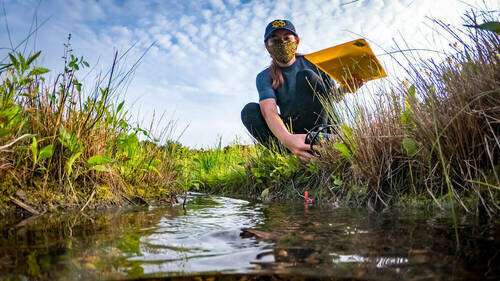Building resilient farmlands in the Midwest

In the Midwest, climate change has battered states with flooding, drought and erosion. Extreme weather events have made for unpredictable crop yields.
On top of production challenges, the region faces declining water quality, risks of algae blooms and invasive species.
Tank's research focuses on understanding the impact of agriculture on freshwater in an effort to guide effective implementation of stream management and conservation efforts.
"The type of research that we do is inspired by and in partnership with managers, policymakers and folks on the ground so it can have faster and more impactful outcomes," said Jennifer Tank, the Ludmilla F., Stephen J., and Robert T. Galla Professor of Biological Sciences and director of the Notre Dame Environmental Change Initiative.
Her latest collaboration with Indiana University seeks to gain a deeper understanding of how cover crops impact carbon, nutrient, water and energy cycles; address knowledge gaps; and identify the social and environmental factors that determine the climate mitigation and adaptation potential of cover crops for Midwestern U.S. croplands.
The team will lead intensive field campaigns combined with state-of-the-art remote sensing to improve understanding about how cover crops make agroecosystems more resilient to climate change, but the interdisciplinary group will also incorporate surveys and economic modeling to determine whether farmers will adopt cover crops at the scale necessary to impact regional resilience.
"Determining practices that can be applied writ large across the corn belt doesn't make sense if you don't understand the drivers and motivation of the behavior and the economic impacts," said Tank. "The economics, the social science and the biogeochemistry all get equal billing for a comprehensive approach."
The challenges farmers face in the U.S. and abroad is just one example that underscores the need for climate resilience.
"Farmers don't know what to expect," Tank explained. "Not knowing what the year will bring is incredibly stressful—both financially and operationally. Will it be a year when they're hit with a 2,000-year storm that results in significant loss of soil in the fields? Will it be a year of no snow and no rain—or rain on top of snow? Will the spring be so wet they can't get into the fields to plant or so dry there's little chance of successful seed germination? Year-to-year variation and extreme events are taxing agriculture in the Midwest. So, when we talk about things like cover crops and restored floodplains—these are some of the resilience tools we're offering farmers to cope with the uncertainty of the future and to operate profitably."
Provided by University of Notre Dame





















